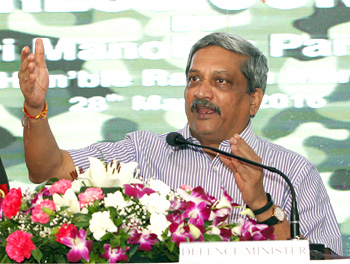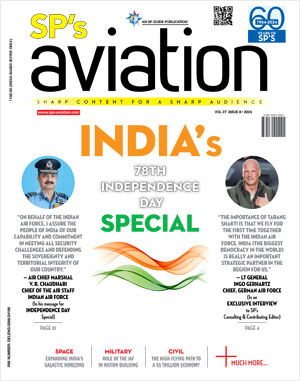INDIAN ARMED FORCES CHIEFS ON OUR RELENTLESS AND FOCUSED PUBLISHING EFFORTS

SP Guide Publications puts forth a well compiled articulation of issues, pursuits and accomplishments of the Indian Army, over the years

"Over the past 60 years, the growth of SP Guide Publications has mirrored the rising stature of Indian Navy. Its well-researched and informative magazines on Defence and Aerospace sector have served to shape an educated opinion of our military personnel, policy makers and the public alike. I wish SP's Publication team continued success, fair winds and following seas in all future endeavour!"

Since, its inception in 1964, SP Guide Publications has consistently demonstrated commitment to high-quality journalism in the aerospace and defence sectors, earning a well-deserved reputation as Asia's largest media house in this domain. I wish SP Guide Publications continued success in its pursuit of excellence.
DPP 2016 the long and short of it
 |
By Lt. General P.C. Katoch Former Director General of Information Systems, Indian Army |

DPP 2016 was released by Defence Minister Manohar Parrikar on 28 March 2016 coinciding with the inauguration of DefExpo 2016 in Goa showing how much Indian Defence has haphazardly progressed. That unlike Delhi no mid level officers who take professional decisions could visit DefExpo 2016 is another issue - only top brass meeting top brass from abroad. As a prelude to DPP 2016, when the Defence Acquisition Council (DAC) cleared the clause of increased offset baseline from Rs. 300 crore to Rs. 2,000 crore besides focusing on reducing delays in procurements, the Defence Minister had stressed the new DPP will ensure modernization of defence forces remains unaffected due to procedural intricacies.
The media had also highlighted the proposed DPP focuses on: reducing delays in procurements by eliminating repetitive procedures; new clauses allowing procurements in through single vendor with proper justification; government readiness to pay 10% extra for products better than others; new category of Indigenously Designed Developed and Manufactured (IDDM) as the most preferred category for procurements, and; the three services to each have dedicated ‘Project Management Units’ headed by two-star general rank officers driving all ‘Make’ projects relating to respective service. ‘Make’ procedure was proposed to be divided in three sub-categories: Make I involving 90% funding of development cost by government; government refunding 100% development cost in Make II in case request for proposal (RFP) not issued within two years of developing prototype; and Make III reserved for small and medium scale enterprises (MSMEs) for projects worth less than Rs. 3 crore.
DPP 2016 was also to lay down benchmarks for selection of private strategic partners from among Indian or foreign firms. Ironically, just before release of DPP 2016, the media quoted the Defence Minister saying that the issue of selection of strategic partner would take another two-three months as discussions on the same were ongoing. So, the most important ingredient of the new DPP linked with private sector participation is still missing, for which the private industry was waiting with baited breath to see the manner in which this is implemented since any loopholes could be used to the disadvantage of some, rather than ensuring a level playing field. Significantly, when PM Modi met top businessmen of Saudi Arabia in Riyadh recently and asked them to invest in Defence in India, they asked him why Indian private sector was not investing adequately in our defence sector. It is ironical that the issue of strategic partners has been left out despite the long time taken to define the new DPP and especially when the Dhirendra Singh Committee had spelt out guidelines for choosing strategic partners. It goes without saying that choosing strategic partners will have political connotations and will invariably change with different ruling parties at the Centre. So why delay the decision? What will be resolved in next two-three months that could not be resolve past several months unless the intention is to let ambiguity continue?
The plusses in the DPP 2016 include introduction of the new procurement category ‘Buy IDDM’; buying indigenously designed, developed and manufactured products with minimum 40% indigenous content, and if not designed and developed indigenously with minimum 60% indigenous content. ‘Buy (IDDM) should ostensibly replace ‘Buy (Indian)’ since latter also now requires 40% indigenous content instead of erstwhile 30%. How the acquisition process will be shortened will need to be observed through the application of the new DPP on ground because the stages of acquisition cycle remain practically same. Other plusses include: Services Qualitative Requirements (SQRs) split into two categories as essential and desirable (Essential Parameters A and Essential Parameters B) with contracts signed based on A and vendor permitted to develop B after award of contract; Services Equipment Policy Committees (SEPCs) responsible for finalising SQRs permitted to seek expert assistance; RFPs will include Enhanced Performance Parameters (enhanced capabilities over and above the essential parameters) with vendors meeting additional parameters given weightage up 10% for determining lowest bid; threshold for offsets raised from INR 300 crore to 2,000 crore; procedure defined to deal with change in name of vendor during procurement cycle for any reason including merger, acquisitions etc; provision for adoption of a model wherein the foreign vendor can select an Indian Production Agency (IPA) from the private sector of its choice when MoD has not nominated a DPSU for the joint venture (JV) albeit if several Indian companies tie up with the foreign vendor, it will not be treated as ‘single vendor’; funding of projects by the MoD increased from 80% to 90%, with balance 10% reimbursed (if RFP not issued within two years of successful development of prototype) and development agencies given mobilization advance of 20% of estimated cost of development; projects with estimated development cost of 10 crore under Make category funded by Mod and 3 core for Make category self-funded by developers will be earmarked for MSMEs, opened to others only if MSMEs don’t evince interest; Annual Acquisition Plan (AAP) for Make projects to be notified by MoD; sharing future military needs with industry through a Technology Perspective and Capability Roadmap (TPCR), covering 15-years acquisition plans.
The minuses besides the void of benchmarking strategic partners include: whether wholly-owned subsidiaries of foreign companies qualify as Indian Offset Partners (IOPs) is not addressed; detailed offset guidelines not notified; no changes mentioned to the TPCR in vogue past decade and a half which hasn’t helped much; no worthwhile changes in other procedures including the Fast Track Procedure (FTP); and chapter containing the revised standard contract document as well as various annexure and appendices not released, without which DPP 2016 is quite incomplete. So what was the great hurry in releasing it including when the issue of strategic partners remains unaddressed? What can be more proof of haphazard and lopsided functioning? But as they say, the proof of the pudding lies in its eating. But while we await the missing parts of DPP 2016, too much hanky-panky is going on in the governmental defence-industrial complex with connivance of MoD, Nishant followed by Akash finally dumped after crores and years wasted being just two examples. What we perhaps need is a monitoring body for defence procurement independent and above the MoD, with adequate powers as part of the Parliamentary Standing Committee on Defence. Finally, policies and procedures don’t matter much if there is indecisiveness and lack of will. When the Defence Minister announces ‘emergent’ procurement of 50,000 bullet proof jackets in 2014 and these have still not arrived despite army’s deficiency having gone up beyond 3,50,000 what streamlining and fast tracking are we talking about?
Photo Credit: DPR Defence





